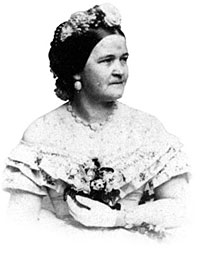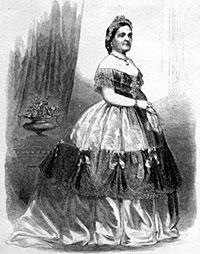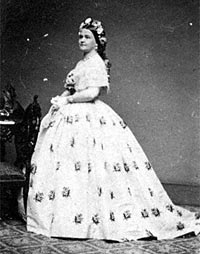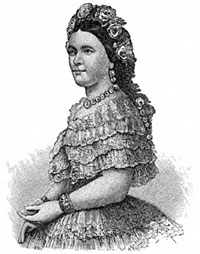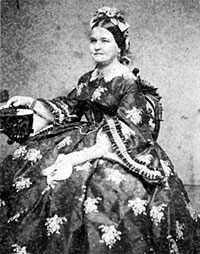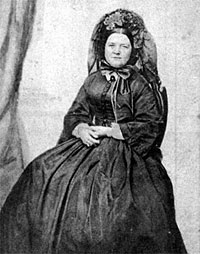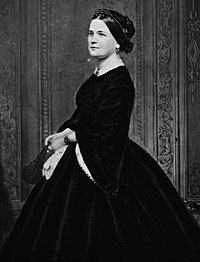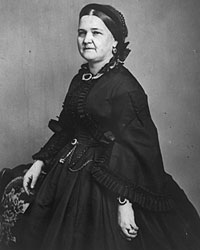Called “Mother” by Mr. Lincoln, Mary Todd was the fourth child of Robert and Eliza Parker Todd. Raised in Lexington, Kentucky, Mary came to Springfield, Illinois to visit her sisters in 1840. After a tumultuous courtship, she married Abraham Lincoln on November 4, 1842. Often self-absorbed and petulant, she was nonetheless devoted to her immediate family while frequently engaged in feuds with other family members. As a young woman, Mary was as buoyant and debonair as she was bitter and dour as a widow. Raised in a slave-owning family, she became a fervent abolitionist, one of whose closest friends was her black seamstress, Elizabeth Keckley.
Her southern background and Illinois husband led to snobbish questions about her social grace when she arrived in Washington. Mrs. Lincoln was caught between northern prejudice of her southern background and southern prejudice of her northern sympathies. Recent First Ladies had been virtually invisible in Washington. Mary Todd Lincoln would not be invisible – and thus became the subject of vicious gossip which her own imprudent behavior encouraged. British journalist William Howard Russell, the correspondent for the London Times, described her shortly after observing Mrs. Lincoln at her first state dinner.
Mrs. Lincoln was already seated to receive her guests. She is of the middle age and height, of a plumpness degenerating to the embonpoint natural to her years; her features are plain, her nose and mouth of an ordinary type, and her manners and appearance homely, stiffened, however, by the consciousness that her position requires her to be something more than plain Mrs. Lincoln, the wife of the Illinois lawyer; she is profuse in the introduction of the word ‘sir’ in every sentence, which is now almost an Americanism confined to certain classes, although it was once as common in England. Her dress I shall not attempt to describe, though it was very gorgeous and highly coloured. She handled a fan with much energy, displaying a round, well-proportioned arm, and was adorned with some simple jewelery. She struck me as being desirous of making herself agreeable, and I own I was agreeably disappointed, as the Secessionist ladies at Washington had been amusing themselves by anecdotes which could scarcely have been founded on fact.1
“Being under scrutiny as a fashion symbol, the first lady’s popularity was as precarious as a roller-coaster ride – sometimes up and often down, with change in the blink of an eye. Her fastidious attention to matters of dress at first impressed and recommended her to the press,” wrote biographer Catherine Clinton. “The rumored costs of her attire became the subject of Washington gossip and prompted bitter critiques by journalists, especially as Union soldiers fell by the thousands, maimed and wounded, dying in camp and on the battlefield.”2
Mrs. Lincoln’s insecurities led her to overindulge in redecorating the White House and herself. Alternatively a spendthrift and a miser, her frequent shopping trips to New York and expensive redecorating in 1861 led to questions about her taste and extravagance. One memorable four-month period saw her collect about 400 pairs of gloves. Her own tastes in clothes followed European fashions, especially those of French Empress Eugénie and caused comment inside and outside of Washington. Even her husband was sometimes surprised by her low-cut dresses. She attempted, where possible, to get her clothes as gifts, but sometimes she misunderstood a purchase as a gift and was surprised when the merchants’ bills began to pile up. Her life was further complicated by those who actually gave her gifts, hoping that in exchange she would press her husband for a job or favor.
Even during the period in 1862 and 1863 when Mrs. Lincoln was in mourning for her son Willie and wore only black, she managed to go further into debt for new clothes. By 1864, she told Elizabeth Keckley: “The President glances at my rich dresses and is happy to believe that the few hundred dollars that I obtain from him supply all my wants. I must dress in costly materials. The people scrutinize every article that I wear with critical curiosity… If he is elected, I can keep him in ignorance of my affairs, but if he is defeated, then the bills will be sent.”3 Only on January 1, 1865 did she completely shed her mourning attire.
Although she frequently abandoned Washington on shopping and vacation trips, Mrs. Lincoln refused to abandon the White House at the outset of the Civil War in 1861 when General Winfield Scott suggested it for security reasons. Her preoccupation with money and spending led her into frequent conflict with the White House staff who called her “the Madam” and the President’s secretaries, who referred to her as the “hellcat.” Journalist Charles A. Dana related an incident in which Mrs. Lincoln’s irritation was directed at her husband in the spring of 1861. Dana and other New Yorkers were engaged in an interview in the President’s office when a messenger interrupted them with a message for Mr. Lincoln:
‘She wants you.’
‘Yes, yes, said Mr. Lincoln without stirring.
Soon afterward the messenger returned again, exclaiming:
‘I say she wants you!
The President, though annoyed, ignored Mrs. Lincoln’s exasperation and continued the interview.4
In a letter to John T. Delane, February 11, 1862, William Howard Russell reflected the kind of abuse to which the president’s wife was subjected: “Did you cast your eye over the acc[ount] of Mrs. Lincoln’s Ball? Was there ever such snobbery & ridiculous sickening trash? She’s like a damned old Irish or Scotch (or English) washerwoman dressed out for a Sunday at Highbury Barn. As a Paddy friend of mine said when he saw her ‘My God! Where’s her apples & pairs?'”5
A month later on March 11, 1862, the President himself wrote an official in the Treasury Department: “Once or twice since I have been in this House, accounts have been presented at your bureau, which were incorrect. I shall be personally and greatly obliged to you if you will carefully scan any account which comes from here; and if in any there shall appear the least semblance of wrong, make it known to me directly.”6 Mary was in nominal charge of the White House’s non-official operations. “She is absolute mistress of all that part of the White House inside of the vestibule on the first floor, and of all the upper floor east of the folding doors across the hall at the head of the stairs. She has had varied assistance in the management of her domain since she came into possession of it,” wrote presidential aide William O. Stoddard.7
Mary’s questionable judgment and trust in friends, associates, and employees led to particular embarrassment of the President. Her lack of discretion extended to both action and comment. She was a source of information for anyone who could manage to obtain her confidence. Seekers of favors and offices often sought her out when they could not influence her husband. Journalist Henry Villard observed in 1861 that “she allowed herself to be approached, and continuously surrounded by a common set of men and women, who, through her susceptibility to even the most barefaced flattery, easily gained a controlling influence over her…”8 She even attempted to influence the selection of cabinet members and judges of the U.S. Supreme Court – although without much effect.
After Willie’s death, her grief and her desire to communicate with him made her vulnerable to phony mediums and spiritualists. Nearly a year after Willie’s death on January 1, 1863 Orville Browning wrote: “Mrs. Lincoln has been out to see a spiritualist who has made wonderful revelations to her about her son Willie. Among other things [the spiritualist] revealed that the cabinet were all enemies of the President.”9 Writing in 1887, John Nicolay said of Mrs. Lincoln’s supposedly bizarre behavior:
These accounts [of her] are very much overdrawn. I was in the official family of Mr. Lincoln during his entire term, and never saw anything to justify such statements as have been made about Mrs. Lincoln at that time. That she was very eccentric there is no doubt, but [that] she went to the extremes reported I do not believe…She had her likes and dislikes. For instance, she never liked Secretary Seward…I don’t think she liked me, but I never knew her to so far forget herself as to make a fuss about it. At the Executive Mansion she would receive of evening fifteen and twenty ladies and gentlemen without any exhibitions of undue nervousness or excitement. She was a woman of great frankness and would speak her mind out.”10
Mary loved conversation – in French or English – and had always relished social occasions. Historian George Bancroft recorded the breadth of her conversational repertoire on one occasion – from politics and secessionist brothers to White House redecorating and flowers. Unfortunately for her husband, she was not discrete in her discussions and expressed her likes, dislikes and limited insight into state affairs. At the very end of the Civil War, she was accompanied back to Washington by Carl Schurz who reported that she liberally divulged “state secrets.”11
The White House provided her with opportunities to display her social skills. Mary held Tuesday evening and Saturday afternoon levees during the White House social season. Journalist Laura Catherine Redden observed her at one levee: “At all events, the charm of her face was not owing to cosmetics. It was a chubby, good-natured face. It was the face of a woman who enjoyed life, a good joke, good eating, fine clothes, and fine horses and carriages, and luxurious surroundings; but it was also the face of a woman whose affectionate nature was predominant.”12
Guard William Crook, who served at the White House in 1865 took a benevolent view of Mrs. Lincoln’s social graces: “I saw a good deal of Mrs. Lincoln while I was on day duty. Very few who were not about the house realized how exacting were the duties of her position. She was, of course, much absorbed by social duties, which presented difficulties no other President’s wife has had to contend against. The house was filled, the receptions were crowded, with all sorts of people, of all varieties of political conviction, who felt, according to the temper of the time, that they had a perfect right to take up the President’s time with their discourse and to demand of Mrs. Lincoln social consideration. Nor could there be discrimination used at the state dinner-parties; any man who was bearing a part in the events of the day must be invited – and his women folks. Jim Lane, rough old Kansas fighter, dined beside Salmon P. Chase with his patrician instincts. The White House has never, during my forty years’ service, been so entirely given over to the public as during Mr. Lincoln’s administration. The times were too anxious to make of social affairs anything more than an aid to more serious matters. It was necessary, of course; but it made it difficult for a first-lady-in-the-land with any preferences or prejudices not to make enemies on every hand.”13
Mrs. Lincoln also privately entertained a variety of other visitors such as Sen. Charles Sumner, Sen. Ira Harris, journalist and spiritualist Nathaniel P. Willis, New York Postmaster Abram Wakeman and Assistant Secretary of the Navy Gustavus Fox. Lincoln scholar Daniel Mark Epstein wrote: “Mrs. Lincoln’s last beneficial act as a political partner was her tireless courtship of the liberal senator from Massachusetts. Playfully flirtatious but chaste, there was nothing insincere about Mary Lincoln’s pursuit of Charles Sumner.”14
Although she was jealous of her husband’s attentions to other women, she herself caused public comment by her unaccompanied trips through the Northeast and her rather unorthodox friendships with men, including those on the White House staff like John Watt and other government officials like William S. Wood. Watt himself said that “Mrs. Lincoln’s relations with certain men were indecently improper.”15Nevertheless, she was devoted to her husband. “Mary has her husband’s deepest love. This is a matter upon which one woman cannot deceive another,” wrote Elizabeth Blair Lee, whose whole family was close to the Lincolns and who herself was one of Mrs. Lincolns’ few female friends in Washington.16
Mrs. Lincoln also had a more benevolent and less publicized side – as demonstrated by her work with seamstress Elizabeth Keckley to aid freed slaves. “These immense number of Contrabands are suffering intensely, many without bed covering and having to use any bits of carpeting to cover themselves – many dying of want,” wrote the First Lady as she attempted to raise funds for the Contraband Relief Association.17 She also made many visits to Union hospitals to cheer wounded soldiers. William Stoddard observed that “She rarely takes outside company with her upon these errands, and she thereby loses opportunities. Is she were worldly wise she would carry newspaper correspondents, from two to five, of both sexes, every time she went, and she would have them take shorthand notes of what she says to the sick soldiers and of what the sick soldiers say to her. Then she would bring the writers back to the White House, and give them some cake and – and coffee, as a rule, and show them the conservatory.”18
Three of her half-brothers died in Confederate military service during the war – Sam at Shiloh, David at Vicksburg, and Aleck at Baton Rouge. Their deaths and that of the husband of her half-sister Emilie may added to the grief she felt as the result of the death of Willie; however, she pointedly told Elizabeth Keckley that she was not grieve her half-brothers. Her many Confederate relatives led to unfounded questions about her loyalty to the Union. Mary told Elizabeth Keckley that brother Aleck “made his choice long ago. He decided against my husband, through him against me. He has been fighting against us and since he chose to be our deadly enemy, I see no special reason why I should bitterly mourn his death.”19 Others of Mary’s relatives became a burden to Mr. Lincoln when he became president, often seeking patronage appointments and special favors.
On July 3,1863, Mrs. Lincoln was thrown from her carriage near Mount Pleasant Hospital, hit her head and was seriously injured. Doctors from the hospital responded and returned her to the White House, where she recovered from a serious gash to her head. Whenever possible, she got her husband out for a drive in the fresh air at four in the afternoon. Together, they sometimes stopped at army hospitals and greeted wounded and sick soldiers. On their last drive together on the afternoon he was assassinated, he told his wife, “I consider this day, the war has come to a close. We must both be more cheerful in the future – between the war & the loss of our darling Willie – we have both, been very miserable.”20
The Civil War and the White House years had strained their marriage. Historian Matthew Pinsker wrote: “Frustrated by her private grief and poor health, nineteenth-century gender conventions, and her husband’s near-constant state of exhaustion, the First Lady found it difficult to connect to him and to support him in his enormous endeavors.”21 Biographer Catherine Clinton noted that by 1865 Mary Lincoln “had been all but excluded from his circle of trusted advisers because of her troubling mood swings, her prolonged absences, and her capricious behavior.”22
Mrs. Lincoln’s trip to the Richmond front in late March 1865 was marked by several explosions of temper. Naval officer John S. Barnes wrote that Mary Lincoln “was at no time well; the mental strain upon her was great, betrayed by extreme nervousness approaching hysteria, causing misapprehensions, extreme sensitiveness as to slights, or want of politeness or consideration. I had the greatest sympathy for her, and for Mr. Lincoln, who I am sure felt deep anxiety for her. His manner toward her was always that of the most affectionate solicitude, so marked, so gentle and unaffected that no one could see them together without being impressed by it. I remember that in several telegrams from Mr. Stanton, he always inquired for Mrs. Lincoln and requested his remembrances to her.”23
Her husband’s death and her financial debts from shopping sprees immobilized her. It took over a month for her to recover enough from the president’s death to leave the White House finally on May 22, 1865. For the next 17 years, she assumed the role of the martyr-widow, consumed by physical and mental illness, bedeviled by personal tragedy and personal torment, and shamed by family and country. She exiled herself to Europe in 1868 after public controversies over her finances and remained there until 1871 when she returned to Chicago. She was committed to an insane asylum by her son Robert in 1875 although she later won her release. On July 16, 1882, Mary Todd Lincoln died at the home of her sister in Springfield.
Footnotes
- Fletcher Pratt, editor, William Howard Russell, My Diary, North and South, pp. 26-27.
- Catherine Clinton, “Wife Versus Widow: Clashing Perspectives on Mary Lincoln’s Legacy,” Journal of the Abraham Lincoln Association, Winter 2007, p. 15.
- Elizabeth Keckley, Behind the Scenes, p. 149-150.
- Allen Thorndike Rice, editor, Reminiscences of Lincoln, p. 364.
- William Howard Russell’s Civil War Private Diary and Letters, 1861-1862, p. 222.
- Harold Holzer, The Lincoln Mailbag, p. 45.
- William O. Stoddard, Inside the White House in War Times, p. 62.
- Henry Villard, Lincoln on the Eve of ’61, p. 103.
- Theodore Pease, editor, Diary of Orville Hickman Browning, Vol. 2, p. 608.
- Helen Nicolay, Lincoln’s Secretary, p. 193.
- Hans L. Trefousse, Carl Schurz: A Biography, p. 148.
- Ruth Painter Randall, Mary Lincoln: Biography of a Marriage, p. 198.
- Margarita Spalding Gerry, editor, Through Five Administrations: Reminiscences of Colonel William H. Crook, pp. 17-18.
- Daniel Mark Epstein, The Lincolns: Portrait of a Marriage, p. 497.
- Michael Burlingame, The Inner World of Abraham Lincoln, p. 292.
- Jean H. Baker, Mary Todd Lincoln, p. 228.
- Baker, Mary Todd Lincoln, p. 231.
- Michael Burlingame, editor, Inside the White House in War Times, p. 48.
- Elizabeth Keckley, Behind the Scenes, pp. 135-36.
- Randall, Mary Lincoln: Biography of a Marriage, p. 342
- John Y. Simon, Harold Holzer, and Dawn Vogel, editors, Lincoln Revisited, pp. 88-89 (Matthew Pinsker, “Abraham Lincoln and the Soldiers’ Home”).
- Catherine Clinton, Mrs. Lincoln, p. 223.
- John S. Barnes, “With Lincoln from Washington to Richmond in 1865,” Appleton’s Magazine, May 1907, p. 743.
Visit
Emilie Todd Helm
William O. Stoddard
Robert Lincoln
William Wallace Lincoln
Thomas D. Lincoln
Benjamin Brown French
William S. Wood
John Watt
Elizabeth Keckley
John Nicolay
John Hay
Anson G. Henry
David Davis
Orville H. Browning
Thomas Stackpole
Mary’s Charlatans
Mrs. Lincoln’s Bedroom
Red Room
Blue Room
East Room
State Dining Room
Lord Colchester
Lyman Trumbull
Elizabeth Todd Grimsley
Gideon Welles
Family Library
Family Dining Room
Biography
Abraham Lincoln and Mary Todd Lincoln
Social Relationships (Mr. Lincoln and Friends)
Mrs. Lincoln’s Shopping (Mr. Lincoln and New York)
Abram Wakeman (Mr. Lincoln and New York)

